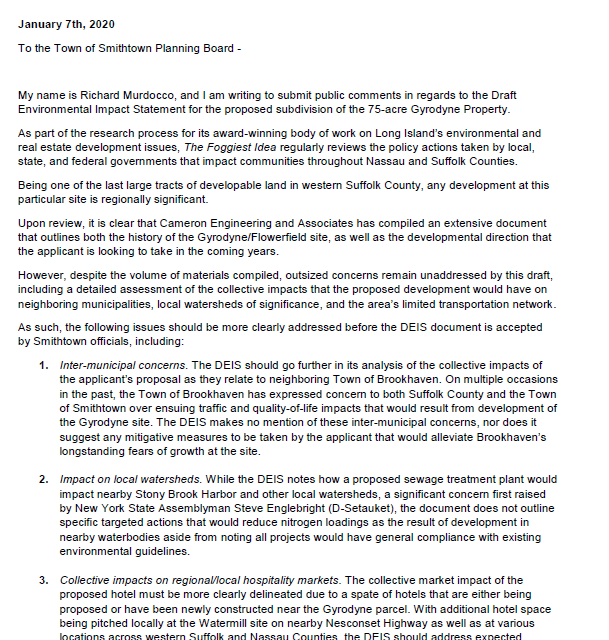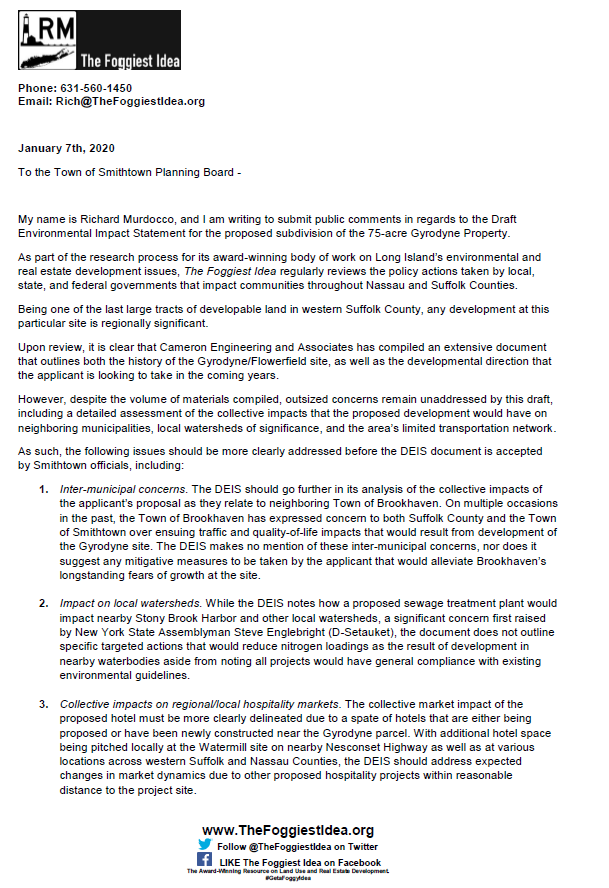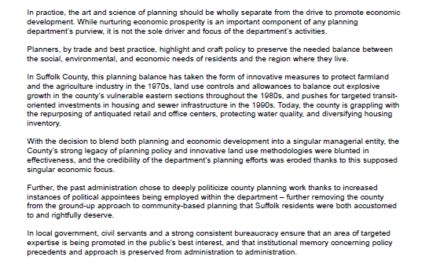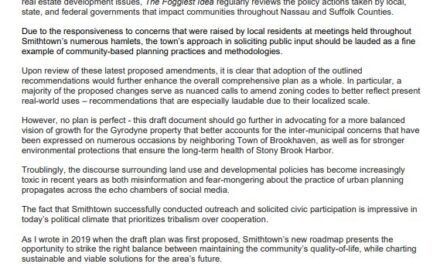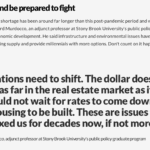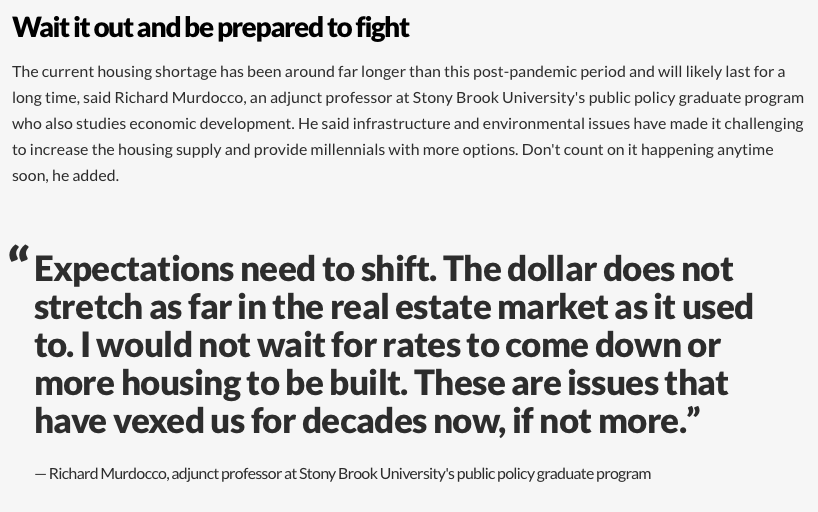The following comments were formally submitted on January 7th, 2020 to members of the Town of Smithtown’s Planning Board. These remarks were published by Smithtown Matters, and a modified version was featured by the Times of Smithtown. Scroll down to find a copy of public remarks delivered at the standing-room only public hearing held on January 8th, 2020.
Interested in supporting The Foggiest Idea’s award-winning reporting and analysis? Click here.
To the Town of Smithtown Planning Board –
My name is Richard Murdocco, and I am writing to submit public comments in regards to the Draft Environmental Impact Statement for the proposed subdivision of the 75-acre Gyrodyne Property.
As part of the research process for its award-winning body of work on Long Island’s environmental and real estate development issues, The Foggiest Idea regularly reviews the policy actions taken by local, state, and federal governments that impact communities throughout Nassau and Suffolk Counties.
Being one of the last large tracts of developable land in western Suffolk County, any development at this particular site is regionally significant.
Upon review, it is clear that Cameron Engineering and Associates has compiled an extensive document that outlines both the history of the Gyrodyne/Flowerfield site, as well as the developmental direction that the applicant is looking to take in the coming years.
However, despite the volume of materials compiled, outsized concerns remain unaddressed by this draft, including a detailed assessment of the collective impacts that the proposed development would have on neighboring municipalities, local watersheds of significance, and the area’s limited transportation network.
As such, the following issues should be more clearly addressed before the DEIS document is accepted by Smithtown officials, including:
1. Inter-municipal concerns. The DEIS should go further in its analysis of the collective impacts of the applicant’s proposal as they relate to neighboring Town of Brookhaven. On multiple occasions in the past, the Town of Brookhaven has expressed concern to both Suffolk County and the Town of Smithtown over ensuing traffic and quality-of-life impacts that would result from development of the Gyrodyne site. The DEIS makes no mention of these inter-municipal concerns, nor does it suggest any mitigative measures to be taken by the applicant that would alleviate Brookhaven’s longstanding fears of growth at the site.
2. Impact on local watersheds. While the DEIS notes how a proposed sewage treatment plant would impact nearby Stony Brook Harbor and other local watersheds, a significant concern first raised by New York State Assemblyman Steve Englebright (D-Setauket), the document does not outline specific targeted actions that would reduce nitrogen loadings as the result of development in nearby waterbodies aside from noting all projects would have general compliance with existing environmental guidelines.
3. Collective impacts on regional/local hospitality markets. The collective market impact of the proposed hotel must be more clearly delineated due to a spate of hotels that are either being proposed or have been newly constructed near the Gyrodyne parcel. With additional hotel space being pitched locally at the Watermill site on nearby Nesconset Highway as well as at various locations across western Suffolk and Nassau Counties, the DEIS should address expected changes in market dynamics due to other proposed hospitality projects within reasonable distance to the project site.
4. Further exploration of a scaled-down As-of-Right alternative. The DEIS should engage in a more detailed exploration of the as-of-right development options at the Gyrodyne site. While the document favorably compares the applicant’s proposal with the impacts of a hypothetical 382,500 square foot light-industrial project allowed as-of-right under the parcel’s current zoning, more options that reflect less-than full build-out should be seriously explored and compared.
More broadly, it is concerning to review a DEIS document that editorializes in favor of the applicant’s proposed direction within the narrative. In this draft, such bias is evidenced by the DEIS’ frequent mention of “synergy” with nearby Stony Brook University, the positioning of the proposal as a favorable complement to a lightly-sourced analysis of existing market conditions, as well as the declaration that the proposal is “sustainable” in the document’s opening lines.
Such analyses should let the findings and data speak for themselves. Otherwise, the authors risk eroding their credibility on developmental matters with both policymakers and the public alike.
Sincerely –
Richard Murdocco
Founder/President
The Foggiest Idea Inc.
Good evening – my name is Richard Murdocco, and I am here to give my comments on the Draft Environmental Impact Statement for the proposed subdivision of the 75-acre Gyrodyne Property.
For those of you who do not know me, I write on land use and real estate development issues. My award-winning published work is regularly seen in Newsday, the NY Daily News, Crain’s NY Business, the Real Deal, and my site, www.TheFoggiestIdea.org. I also teach graduate-level courses on economic development and urban planning.
The Foggiest Idea regularly reviews the policy actions taken by local, state, and federal governments that impact communities throughout Nassau and Suffolk Counties. Being that Gyrodyne is one of the last large tracts of developable land in western Suffolk County, any development at this particular site is regionally significant.
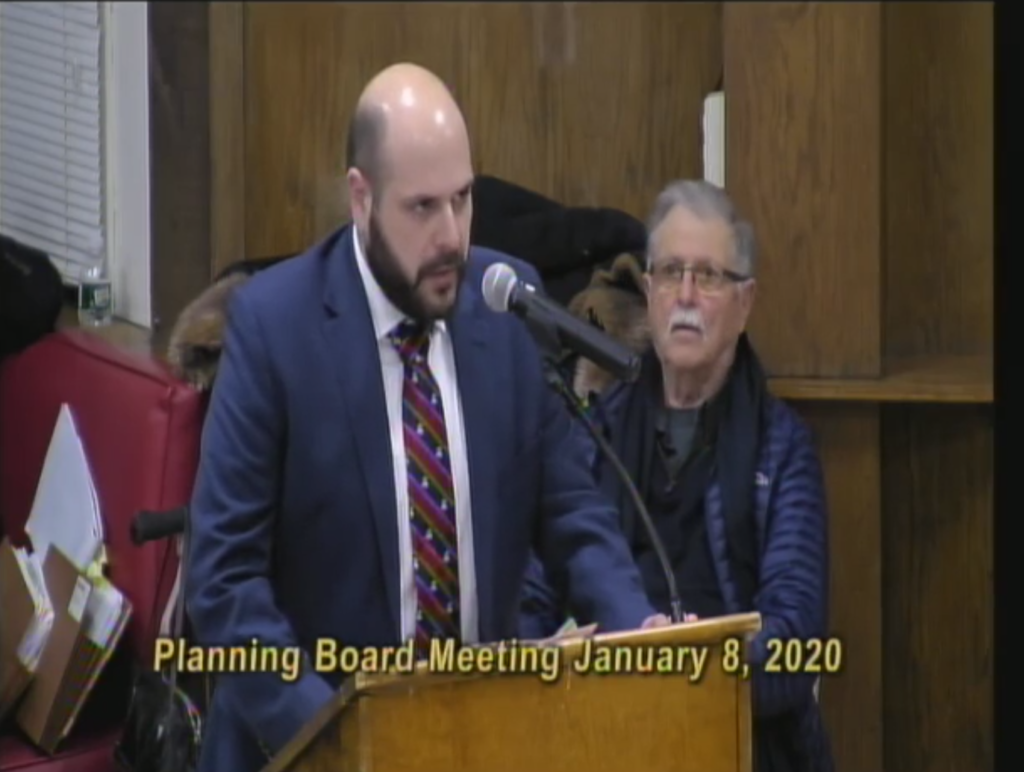
Pictured: Richard Murdocco, Founder of The Foggiest Idea, speaking about development at Gyrodyne (Credit: Town of Smithtown)
In my formally submitted remarks to the planning board earlier this week, (which are available online and have been published by local media outlets), I noted that while the DEIS is an extensive document, outsized concerns remain unaddressed by the draft, including the impacts to neighboring municipalities and on local watersheds.
Tonight I’d like to focus on two distinct elements – comprehensive impacts, and inter-municipal relations between both the Towns of Brookhaven and Smithtown.
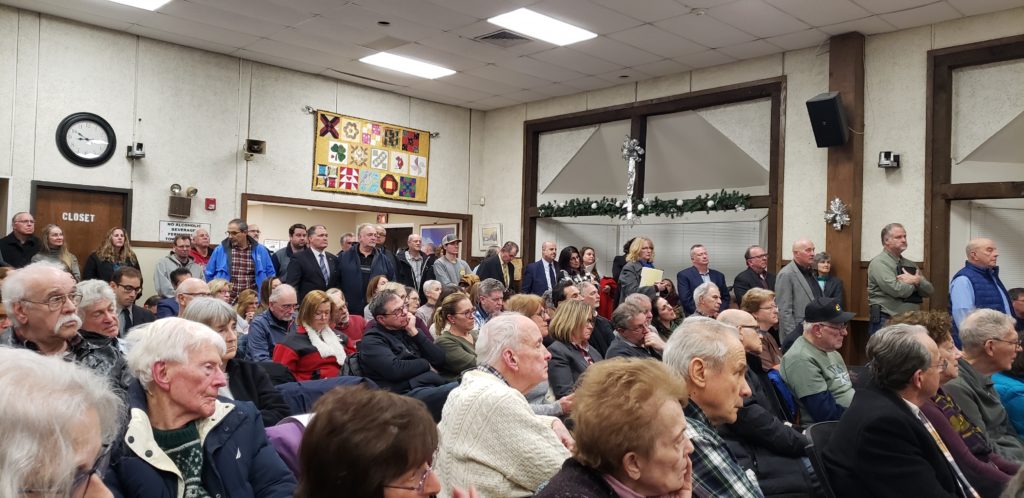
Pictured: The crowd at the Smithtown Planning Board meeting on the DEIS for the subdivision of the Gyrodyne property (Credit: Richard Murdocco)
In recent years, local governments have been isolating the discourse around proposals of regional significance. In Huntington, policymakers found their concerns regarding Heartland Town Square unaddressed by their neighbors in Islip. Smithtown must not follow Islip’s example by failing to listen to Brookhaven’s concerns. In the coming years, inter-municipal cooperation will help determine our regional successes.
Moving forward, I urge policymakers in both towns to work with the Gyrodyne company in crafting a proposal that meets our region’s collective goals of environmental and economic sustainability. Development actions on our island are not isolated, for they resonate far beyond municipal borders.
As such, the comprehensive impact of any developmental effort at Gyrodyne in relation to other proposed projects must be fully understood. Given the infrastructural and environmental limitations that exist around the parcel in question, the DEIS fails to give us a comprehensive understanding of the regional implications of the applicant’s proposal.
In closing, I am confident that all interested parties can come together and craft a vision for these 75 acres. As I argued on the pages of Newsday in 2018, “Long Island’s municipalities must stop pursuing patchwork economic development strategies and come together to properly chart the region’s future.”

